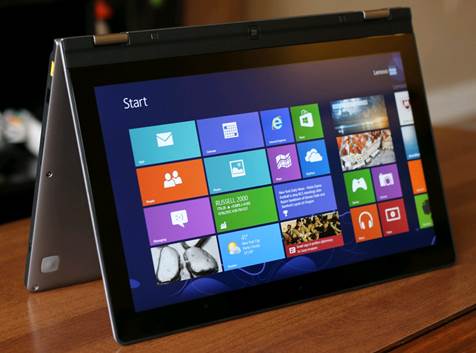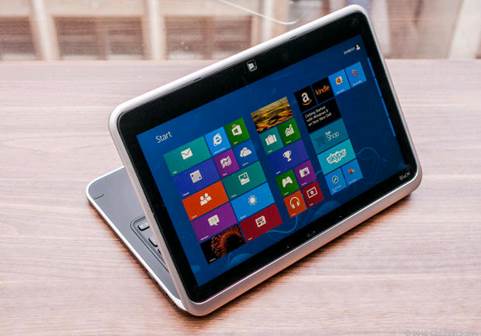Software and warranty
Compared to some other PC manufacturers,
Toshiba includes quite a bit of bloat ware, such as: Netflix, eBay, Amazon,
Vimeo, Encyclopedia Brittanica, the Merriam-Webster dictionary, iHeartRadio,
iCookbook, Origin (EA's game shop ), and a 30-day trial version of Norton
Internet Security 2013. Toshiba also introduced a number of separate items,
including Book Place, News Place and a support guide. At least the bloat ware
in Windows 8 comes up as a pile of additional Live Tiles on the Start Menu;
none of this is topsy-turvy on the desktop. A troublesome thing is that some of
these programs are pinned to the Taskbar, but of course you can remove them if
you want.
Like most consumer laptops, the U925t comes
with a one-year warranty. The battery has a one- year warranty.
The configuration options and competitors
The U925t sold in one configuration on the
Toshiba website: the same 1150 model we tested with Intel Core i5-3317U, 128GB
SSD and 4GB of RAM. We are the fairly typical specs, in terms of Ultrabook,
although some skilled users might complain that they were unable to configure
it with a Core i7 CPU, 8GB of RAM and 256GB of storage.
We have already referred to the most
similar competitors of the U925t: the Dell XPS 12 and the Lenovo IdeaPad Yoga
13. Why did we choose them? Well, we were looking for the Ultrabooks that were
able to be used as tablets - especially, the Ultrabooks with 12 or 13-inch
screens. Anything larger meant that were some serious compromises on mobility.
To keep things brief, we will not stop at the normal old touch screen laptops,
since you are really unable to use them as tablets, even if you are tapping the
screen with your finger. So, that leaves us with a fairly small group of
computers, with the XPS 12 and the Yoga 13 that are the most prominent.

Lenovo
IdeaPad Yoga 13
If you can ignore the strange form factor
of the XPS 12 (its screen flips inside the joint), it is really a stable small
touchscreen Ultrabook. For $1,200 or more, it is as expensive as the U925t, and
has the nearly same technical specifications, including 4GB of RAM, a 128GB SSD
and that Core i5-3317U processor. The big difference is the screen: the XPS 12
comes with 1080p IPS screen and yes, it sounds so cute. The XPS 12 provides
nearly the same battery life as the U925t’s and has the equivalent weight. It
can also be configured with 8GB of RAM and a 256GB SSD. Its design and build
qualities are also excellent, but there is a shortcoming: the lack of an SD reader
card.

Dell
XPS 12
For the Yoga 13, we need to let you know
that we are still testing it, and are not ready to make a decision in the
review explicitly. Let’s make it clear; we are enjoying its comfortable
keyboard and steady build quality. As you can see in the above performance
table, its battery life is slightly better than the U925t’s, and is equal to
the XPS 12. The performance on these three machines appears to be comparable.
In terms of specs, it starts at $1,000 with a Core i3 processor, 4GB of RAM, a
128GB SSD and a 1600x900 screen. To have the same Core i5 CPU employed in the
U925t and the XPS 12, you will have to pay $ 1,100, which still is not as
expensive as the Toshiba model.
Conclusion
If Toshiba did the right thing with its
first high-end Windows 8 computer, it is this: actually, there is the market
for the PCs that can be used as tablets. It is convenient to tuck you
Ultrabook’s keyboard away if necessary, and turn it into a tablet (a big, heavy
tablet, but still a tablet). It is a good choice when you are both sitting on
the sofa and watching TV at the same time: you can feel like taking a glance at
your email or finding the actors on IMDB, but make sure you do not intend to
use the keyboard. Not when you're acting like a loafer.

It
is convenient to tuck you Ultrabook’s keyboard away if necessary, and turn it
into a tablet.
However, the more we used the Satellite
U925t, the more we believed that Toshiba has bet on the wrong form factor. The
screen erected encroaches on the available keyboard’s tray space, creating a
compromised typing experience. The trackpad is also unnecessarily small, which
might disturb those who are trying to complete their work on the desktop and
cannot manage to enter data input with your finger. Meanwhile, the Dell XPS 12
and the Lenovo IdeaPad Yoga 13 have nearly the same prices and weight, except
that they approach the tablet transformation in such a way so that you never
lose the keyboard space.
There are also other problems with the
U925t. Its battery life is shorter than two competitive models we have
mentioned, and the build quality is not as strong as their rivals’.
Furthermore, the XPS 12 comes with a 1080p screen, while the Yoga 13 has a 1,600x900
screen. The display is one of the few bright spots for the U925t, but it has a
low resolution (1,366x768). While the viewing angles are good, they are not as
good as what the other computers offer. We do not want to say that the U925t
does not have the qualities in return for its shortcomings, but with a lot of
other Windows 8 convertibles are available or will be arriving soon, we think
that your money would be spent better elsewhere.
|
Info
·
Product name: Toshiba Satellite U925t
·
Price: $1,150
Advantages
·
The IPS screen offers good viewing angles
·
It can be used in the tablet mode
Disadvantages
·
Sliding design means having the limited
keyboard space.
·
The sound of fan is loud.
·
Battery Life is short.
·
Build quality is not great.
Verdict
·
The U925t slider’s form factor creates
compromised typing experience.
·
Meanwhile, the other Windows 8 convertibles
offer the better screen, battery life, and build quality with the similar
prices.
Toshiba Satellite U925t specifications
·
Laptop type: Ultraportable, Convertible tablet
·
Thickness: 0.7 inches
·
Weight: 3.35 pounds
·
Operating system: Windows 8
·
Screen size (diagonal): 12.5 inches
·
Touch technology: Yes (unspecified)
·
CPU brand: Intel
·
CPU family: Ivy Bridge
·
Graphics type: Integrated
·
Integrated GPU model: HD Graphics 4000
|